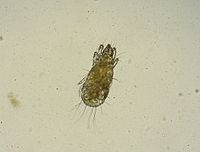
Photo from wikipedia
Simple Summary Panonychus ulmi is a pest of several agriculturally important crops, including apples. If populations are not controlled, it can cause severe foliar damage in apple that results in… Click to show full abstract
Simple Summary Panonychus ulmi is a pest of several agriculturally important crops, including apples. If populations are not controlled, it can cause severe foliar damage in apple that results in lower return bloom and yield loss in following year. Biological mite control of this pest can be achieved in eastern United States apple orchards if growers conserve several species of predatory mites through proper selection and timing of insecticide applications for the main pests such as codling moth which directly damage the fruit. When apple growers occasionally loose biological mite control, they need to rely on effective miticides that also conserve these predatory mite species to maintain sustainable pest mite control. Efficiency of different pesticide chemicals used for the P. ulmi management and their non-target effects on predatory mites conserved for biological mite control in apple orchards are discussed. Abstract Panonychus ulmi (Koch) (Acari: Tetranychidae), commonly known as European red mite, is a polyphagous pest of various tree and small fruit crops, including apples. A field study was conducted to evaluate different pesticide options available for the management of P. ulmi, and their impact on the population of non-target predatory mite species complex consisting of Neoseiulus fallacis, Typhlodromus pyri, and Zetzellia mali in apple orchards. Pesticides were applied using a commercial airblast sprayer at the 3–5 mite/leaf recommended economic Integrated Pest Management (IPM) threshold or prophylactically in the spring ignoring IPM practices such as monitoring, reliance on biological control and economic thresholds. Effects on the motile and egg stages of P. ulmi were evaluated as were effects on the populations of predatory mites through frequent leaf counts during the season. We also recorded the subsequent overwintering eggs of P. ulmi from each pesticide treatment. The two prophylactic treatments containing a mixture of zeta-cypermethrin + avermectin B1 + 1% horticultural oil and abamectin + 1% horticultural oil provided effective control of P. ulmi population throughout the season without reducing predatory mite populations. In contrast, eight treatments applied at the recommended economic threshold of 3–5 mites/leaf were not effective in suppressing P. ulmi populations and most reduced predatory mites. Etoxazole had significantly higher number of overwintering P. ulmi eggs compared to all other treatments.
Journal Title: Insects
Year Published: 2023
Link to full text (if available)
Share on Social Media: Sign Up to like & get
recommendations!